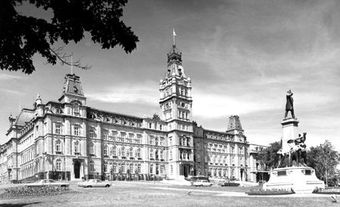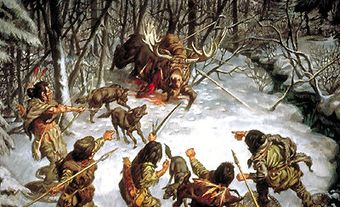Indigenous Peoples
Gatineau is located on the unceded territory of the Algonquin, an Anishinaabe people who have occupied the entire Ottawa watershed for thousands of years. One of the most important and sacred places for the Algonquin is Chaudière Falls on the Ottawa River in Gatineau.
The origin of the name “Gatineau” likely comes from a French derivation of an Anishinaabemowin word for the river, Tenàgàdino Zìbì. The earliest map showing the current name and spelling of the river dates back to 1821.
When the first Europeans arrived, an Algonquin group was settled in an area between the Gatineau and Rouge rivers. However, the group hunted, traded and lived over a much broader territory. Their descendants include members of Kitigan Zibi Anishinabeg First Nation. Kitigan Zibi Anishinabeg is the Algonquin Nation community located closest to Gatineau, about 130 km north (see also Reserves in Quebec).
Dispossession
In the early 17th century, several Europeans travelled up the Ottawa River to explore the country. However, a sustained European presence in the Gatineau region did not begin until the 1760s during the fur trade. Despite the arrival of Europeans, Kitchissippi, as the Ottawa watershed was known in Anishinaabemowin, had not been ceded by the Anishinaabeg. The Government of Quebec enacted laws prohibiting trade within hunting areas and by unlicensed traders and settlers. With little enforcement of the rules, however, incursions by traders and others persisted.
The dispossession of Algonquin land by Europeans accelerated in the late 18th century. Along the Ottawa River, squatters took over fertile places where the Algonquin planted crops. Timber harvesting destroyed the forests and waterways that had sustained the Algonquin for thousands of years. Today, most of that land, including Gatineau, remains unceded territory. No treaty or other legal agreement transferred ownership of Algonquin territory to Canada.
European Settlement
Gatineau and Ottawa’s growth as industrial centres began with the arrival of Philemon Wright and other families between 1796 and 1799. These families came to farm and harvest timber. With the growth of the timber industry, Wright began using the Ottawa River to float logs to the St. Lawrence and on to Quebec City. Labourers came into the area to work for Wright and other businesses in Wrights Town, which was renamed Hull in 1875. This area became the core of Gatineau at amalgamation in 2002.
By the middle of the 19th century, steam-powered lumber mills were the centre of Gatineau’s economy. The next transformation came when J. R. Booth and other lumber business operators arrived in the early 1850s. They expanded operations even further in both Gatineau and Ottawa, bringing more people from other parts of Canada, Europe and the United States. When these people arrived, they worked in the mills and established farms after timber was harvested. Gatineau’s population doubled between 1881 and 1901 from 7,000 to 14,000. Lumber operations were so dense along the Ottawa River that a fire started in the Hull sector of Gatineau on 26 April 1900. Within hours, it had spread to Ottawa. Known as the Great Fire of 1900, it destroyed two-thirds of Hull and huge swaths of Ottawa. (See also Fire Disasters in Canada.)
Today, the history of Gatineau’s industrial development is part of its urban form and character. It can be seen in the hydroelectric installations at Chaudière Falls and in the redevelopment of former industrial buildings into condominiums and offices.
Cityscape
The amalgamation of Gatineau created a city with areas of distinct character. Most major local institutions and many federal government offices are located in the Hull sector. Hull was the core of the urban area before amalgamation and remains so. The Aylmer sector was an ex-urban area with a long history closely tied to the timber industry of the Ottawa Valley. Now, Aylmer is the location of a new residential development stretching along the Ottawa River. The Buckingham sector is the site of a major hydroelectric installation and old neighbourhoods closely connected to the Lièvre River. The importance of agricultural settlement to the history of the area remains evident in the Masson-Angers sector.
Population
Gatineau is the fourth largest city in Quebec, after Montreal, Quebec City and Laval. Based on the 2016 census, 64 per cent of people in Gatineau speak both French and English, but French is the mother tongue for about 75 per cent of the residents. The proportion of the city’s population with a university education is the highest in Quebec.
Economy and Labour Force
Gatineau’s economy was almost entirely dependent on the timber and paper industries until the mid-20th century. At this time, the federal government began systematically moving offices and staff to Gatineau. In 2020, nearly 32,000 federal positions were in Gatineau, compared to 75,000 in Ottawa. In addition to government and construction jobs, Gatineau has a growing high-tech sector.
The city is the home of the Université du Québec en Outaouais, which is part of the Université du Québec network.
Culture and Recreation
Gatineau has a large performing, musical and visual arts community. Recording artist and producer Daniel Lanois was born in Gatineau. National cultural and heritage institutions in Gatineau include the Canadian Museum of History, Library and Archives Canada Preservation Centre, and the research and collections facility of the Canadian Museum of Nature.
Gatineau and its surrounding area, including Gatineau Park, provide many recreational opportunities and places of scenic beauty in all seasons. Residents and visitors enjoy cycling, hiking and, in winter, cross-country skiing from near the centre of the city into the Gatineau Hills. The Ottawa and Gatineau rivers offer numerous water recreation opportunities.

 Share on Facebook
Share on Facebook Share on X
Share on X Share by Email
Share by Email Share on Google Classroom
Share on Google Classroom



